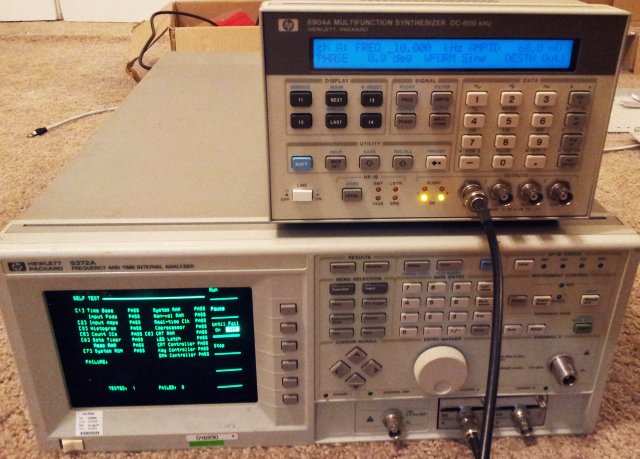For most precise time interval counting, I use a trusty HP 5370A, which has no less than 20 ps single-shot resolution. The 5370A and its inner workings could be discussed for hours (well, pages) here, but this is not the topic of this entry. This is about the 5372A, a much more modern machine – it still measures time intervals, but has a pretty capable build in numerical analyzer. It has a CRT, excellent quality, magnetic deflection, and this provides a nice and sharp green display. It doesnt’t add much weight, because the 5372A is massively heavy anyway, due to all the shielding, and a huge linear transformer. Why did HP use a linear transformer? No idea! Even the most quiet synthesizers can run with some kind of high quality switchmode supplies. Well, in the end, these machines are not build to be carried around but rest, or work, in an adequately thermostated metrology lab.
The 5372A has some very useful functions, not available for many other counters, unless you spent a lot of time developing your on software, work via GPIB; the 5372A can do virtually all of the most exotic tests, just with the single box.
That’s the main CPU, a MC68020 (the first real 32 bit processor ever!!!), and a floating point co-processor, MC68881, and a lot of traces that let the bits flow around.

This one, managed to get it for very little money, with the build-in precision HP 10811 reference OCXO already worth 100, used. And it even has the very desirable Option 030, 2 GHz input. Ideal for measuring locking processes of PLLs (via a triggered frequency vs. time display – shown directly on the screen, as a diagram/graph!), etc.
With the 5372A there are two important things to consider:
(1) It is extremely heavy, and does not ship well, unless it is packages with utmost care. My unit arrived in a big box, and barely made it – don’t even consider international shipment without a lot of bubble wrap, heavy foam, and double-boxes.
You can see the box already damaged; and there was just a single layer of bubble wrap; but I was lucky, the machine survived.
(2) Second item, never get desperate about the “160 out of sens cal error”. This error is well-known for these units, and the 5373A, and its 99% cause is a dead lithium battery on the CPU board. Just replace the battery, and follow the instructions to calibrate.
These are the main parts: a spare AA Li-SOCl2 cell, the CPU board with the dead battery (Tadiran is a really good quality Li-SOCl2 cell). And the new battery fitted (of presumably lesser, OmniCell, Made in China; but will be fine).
Note that this cell had been changed before, and some solder spilled!!
It seems, it didn’t kill the board, but it is removed now.
The calibration, not very spectacular (using a 8904A Source):
With the calibration done – no error displayed any more.
More detail testing will follow, but according to the self test, all is fine!









Question on calibration after changing battery.
Do you have to do complete calibration of just section 3-30?
Thanks
Dave
Hi Dave, I dont recall the precise number, but it ia just a short procedure with a 10 khz signal. Doesnt take very long.
Simon
…just checked it, you are right it is number 3-30 sensitivity call. I didn’t do other calibrations to get it back to service. But sure you want to check the power supply voltages if you have time.
Thanks for the clarification.
Yes that will be easy to do.
Once battery arrives I will get that done.
Good idea to check power supply voltages.
Dave